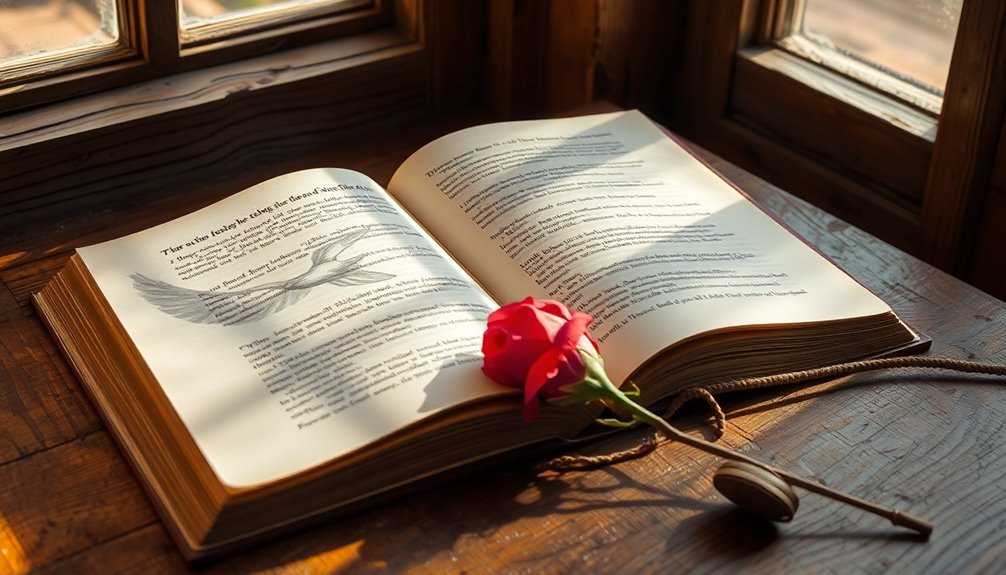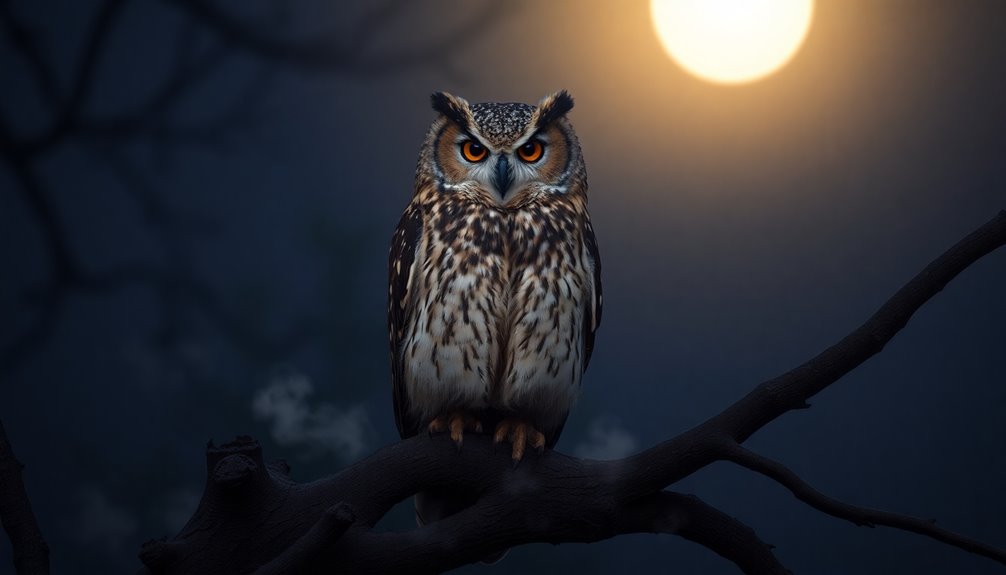Poets use symbolism to turn ordinary words into extraordinary images, letting you feel and explore deeper meanings in their poems. Symbols act like keys, revealing layers of emotions and ideas that may surprise you. You'll find symbols like stars to represent dreams or rivers for the flow of life, which help paint vivid pictures in your mind. They create connections, making the poem more memorable and powerful. By choosing the right symbols, poets invite you to reflect in unique ways. If you keep exploring, you'll discover even more fascinating insights about how symbolism works in poetry!
Key Takeaways
- Symbolism enhances engagement by transforming abstract ideas into vivid, relatable images that resonate with readers' emotions.
- It allows poets to explore complex themes, inviting multiple interpretations and deeper personal insights.
- Cultural and historical symbols add thematic depth, making poetry memorable and impactful across different contexts.
- Effective symbolism fosters emotional connections, encouraging readers to embark on a journey of imagination and reflection.
- Poets use symbolism to create layers of meaning, enriching the poem's message and encouraging thoughtful analysis.
Importance of Symbolism in Poetry
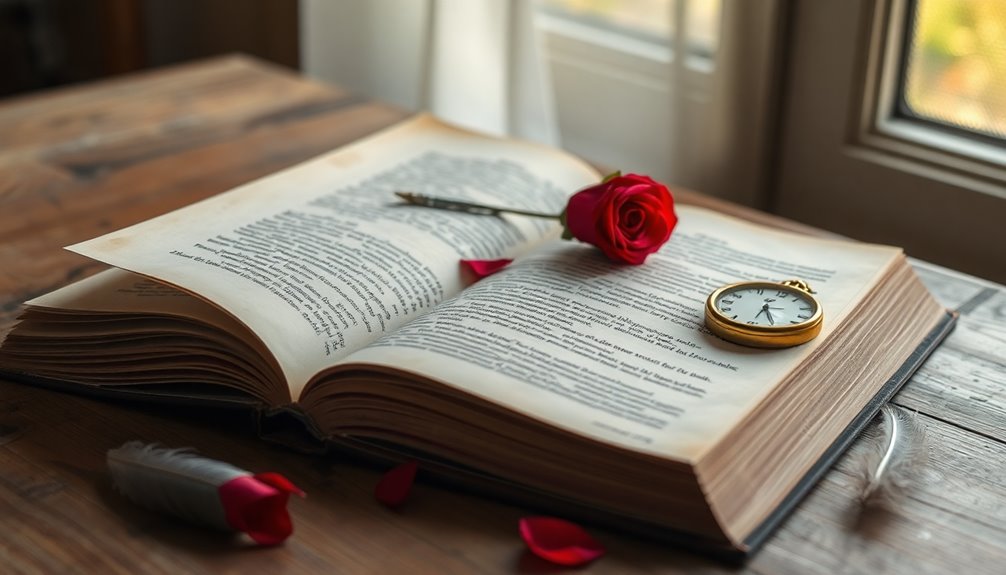
While you might think of poetry as merely words on a page, symbolism plays an essential role in transforming those words into vivid experiences. When poets use symbolism, they connect abstract ideas to images you can see and feel. This connection creates layers of meaning that make the poem richer and more engaging.
Every symbol can hold deep significance, allowing you to explore different interpretations and find your own personal insights. Imagine reading a poem about a storm. The storm might symbolize struggle or change, inviting you to reflect on your own experiences. This emotional connection helps you feel the poem's message more deeply.
Symbols can even resonate culturally or historically, adding extra depth to the themes.
Types of Symbols Used
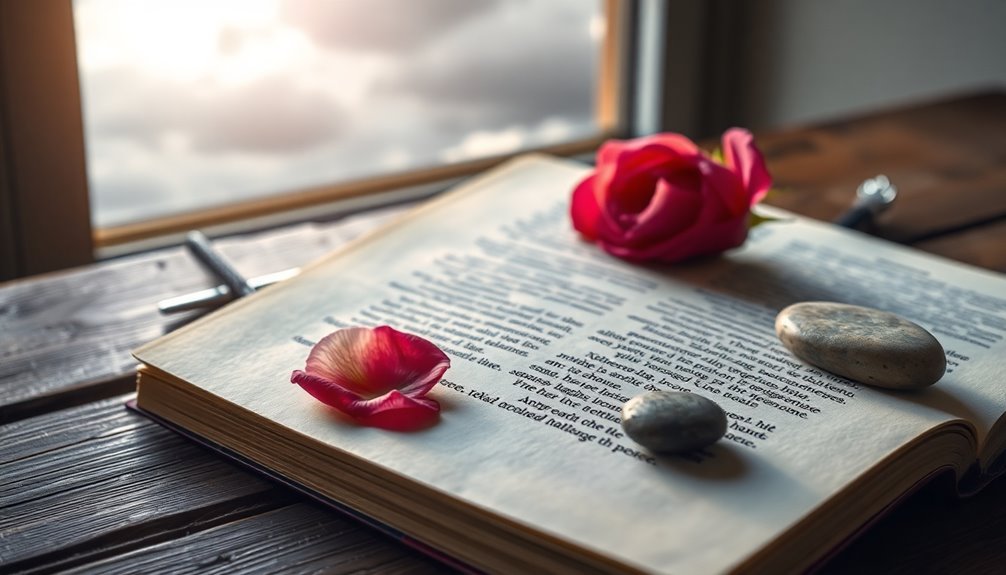
Symbols in poetry come in various forms, each serving a distinct purpose in conveying meaning and emotion. One popular type is metaphors, which compare two different things to create vivid images. For instance, saying "Her eyes were stars" brings emotions to life in a unique way.
Nature symbols are also common in poetry. For example, rivers often symbolize the fleeting nature of life, while trees can represent growth and stability. These images help you connect with deeper themes.
You'll find cultural symbols too, like doves representing peace or roses symbolizing love. These symbols carry specific meanings that resonate with people familiar with those traditions.
Another captivating aspect is color symbolism. Colors can evoke strong feelings; red often symbolizes passion or danger, while white can represent purity or innocence. Curiously, these meanings might change depending on the culture!
Finally, poets love using recurring motifs. These are symbols repeated throughout a poem to create a strong theme. This technique invites you to explore the poem's message more deeply.
Through these various symbols, poets enrich their work, making it more enjoyable and meaningful for you!
Selecting the Right Symbols

Choosing the right symbols can greatly enhance the depth and meaning of your poem. When you're selecting the right symbols, think about how they align with the central message. This helps make your poem clearer and more powerful.
Explore the cultural significance of symbols. This guarantees they resonate emotionally with your audience and avoids any misinterpretation. Additionally, symbols can often carry cultural connotations that deepen their impact, making your poetry more relatable. For instance, using symbols from Punjabi culture can add layers of meaning that resonate with specific emotional experiences.
It's also important to find a balance between familiar and surprising symbols. Familiar symbols can connect instantly, while surprising ones can spark deeper reflection.
Remember, the context of your poem matters too! The tone and subject should guide your choices, so the symbols fit seamlessly into the overall narrative.
During the editing process, take the time to revise and refine your symbols. This is your chance to achieve precision and clarity. Make sure each symbol contributes meaningfully to your poem's impact.
By carefully selecting symbols that have thematic relevance and emotional resonance, your work can truly shine. Additionally, consider how the importance of self-love can influence the way your symbols are perceived, as it shapes the emotional connection with your audience. So, get creative and let your symbols tell a story that captivates your readers, drawing them into the world you've crafted.
Happy writing!
Techniques for Effective Symbolism

Effective symbolism can elevate your poetry, drawing readers deeper into the emotional landscape you've created. To make your symbols shine, think about how they fit into your poem's structure. Allow them to emerge naturally as you write. This way, they feel genuine and connect with your audience.
Repetition is another handy tool. By using the same symbols throughout your poem, you can reinforce themes and ideas, making your message more powerful.
Don't be afraid to combine different symbols, either! This can create layered meanings, inviting readers to explore your work on multiple levels.
Experiment with where and how you place your symbols. The right context can enhance their impact and prompt readers to think about their significance.
Finally, observe life and emotions around you. Doing this will help you choose symbols that resonate authentically with your audience.
Common Challenges With Symbolism
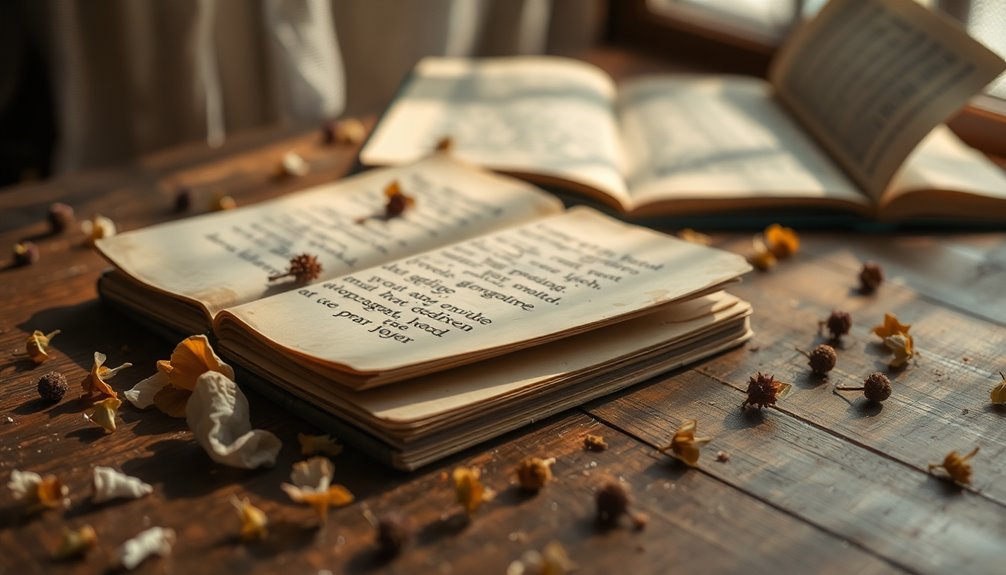
Crafting poetry using symbolism can be rewarding, but it also comes with its share of challenges. Here are three common ones you might face:
- Misinterpretation: If your symbols aren't clear, readers might get confused. This can lead to disengagement, which is the last thing you want!
- Complexity: Using too many complicated symbols can overwhelm your audience. It's important to balance familiar and surprising symbols to keep your message clear and engaging.
- Relatability: Symbols need to resonate with your readers. If they're too obscure or lack emotional connection, your message mightn't land well.
To tackle these challenges, focus on clarity. Make certain your symbols enhance your poem, rather than overshadow it.
Think about how your audience will interpret each symbol. You want them to feel the emotional resonance you intended.
During the editing process, revise and refine your symbols. Test them out with friends or fellow poets to gauge their effectiveness.
This way, you can guarantee your symbols are layered yet accessible, conveying deeper meanings successfully. Embrace the process, and you'll create beautiful poetry that connects with others!
Historical Context of Symbolism

The Symbolism movement started in the late 19th century, mainly in France, because poets wanted to express their feelings in new ways.
Key figures like Charles Baudelaire and Stéphane Mallarmé used symbols to show complex ideas that went beyond what words alone could say.
This exciting shift helped poets connect deeper meanings to everyday experiences, making their work rich with emotion and thought!
Origins of Symbolism Movement
Emerging from the constraints of realism and naturalism, the Symbolism movement took root in late 19th century France, aiming to explore deeper truths through suggestive imagery rather than straightforward representation. This exciting movement was all about expressing abstract ideas and emotions, inviting readers to engage in personal interpretations.
Here are three key aspects to reflect upon:
- Emphasis on Imagery: Symbolist poets used vivid images to spark emotions and thoughts, often leaving you to find your own meaning.
- Influence of Romanticism: This movement drew inspiration from Romanticism, which celebrated imagination and individual feelings.
- Impact on Modern Literature: Symbolism paved the way for modernist literature, encouraging poets to play with form and meaning.
Poets like Stéphane Mallarmé and Paul Verlaine crafted their works with musical qualities, focusing on the beauty of language. They believed that through symbolism, they could convey profound truths about life and existence.
The rise of individualism and psychological exploration in society also influenced this movement.
Key Symbolist Poets
In the late 19th century, key Symbolist poets like Charles Baudelaire, Paul Verlaine, and Stéphane Mallarmé redefined poetry by emphasizing the evocative power of symbols. They believed that words could create magical images that stirred deep emotions. Instead of just telling a story, these poets wanted to share feelings and ideas that went beyond what you see on the page.
Symbolism was a reaction against the realistic styles of their time. These poets explored dreams, spirituality, and the inner self through their mystical symbols. W.B. Yeats, another notable symbolist, often used symbols to express themes of love, loss, and the search for something greater. For example, in "The Lake Isle of Innisfree," he paints a vivid picture that invites many interpretations.
Symbolist poets drew inspiration from myths, folklore, and their own experiences. They created layered meanings that encouraged you to think and feel more deeply. By using symbols, they transformed poetry into an adventure of emotions and thoughts.
You can see how these poets opened doors to new ways of understanding the world, making their work exciting and full of wonder!
Symbolism vs. Allegory

Understanding the distinction between symbolism and allegory enriches your appreciation of poetry. Both are essential tools, but they serve different purposes. Here's a quick look at their differences:
- Symbols use concrete images to represent abstract ideas. They're open to interpretation and can have layered meanings.
- Allegories are complete narratives that convey a specific moral lesson through characters and events. They guide you toward a particular understanding.
- While symbols evoke emotions and provoke thought, allegories often rely on detailed narratives to impart their moral or philosophical lessons.
When you encounter symbolism in poetry, think of how a single image can spark various interpretations. For instance, a rose might symbolize love or beauty, depending on the context.
In contrast, an allegory might tell a story about a journey, with each character representing a moral lesson—like honesty or bravery.
Symbols invite you to explore your feelings and ideas, while allegories lead you to a clear moral. By understanding these differences, you'll dive deeper into the meanings behind the words, making your reading experience even more enjoyable!
Educational Resources for Symbolism
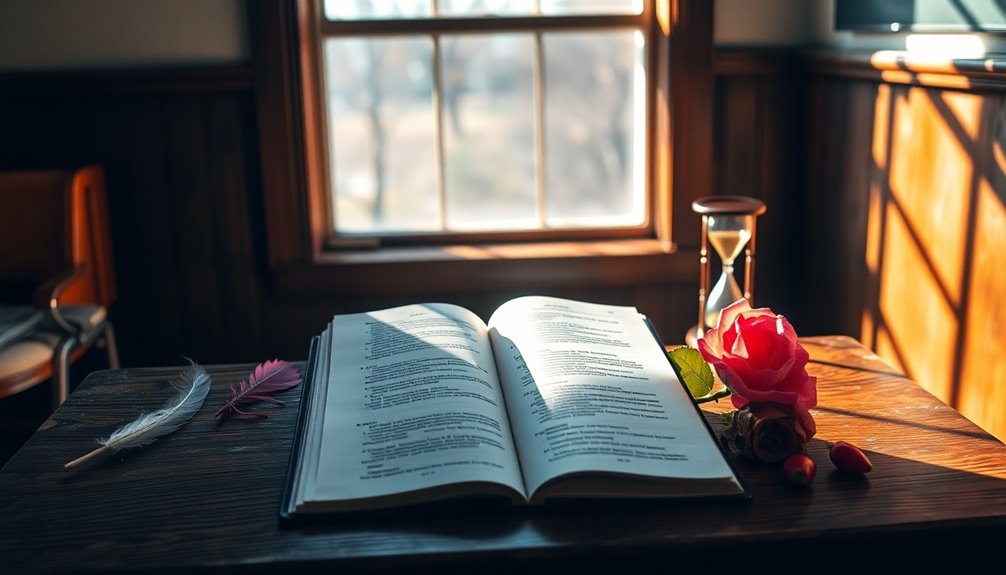
When exploring symbolism in poetry, educational resources play an essential role in helping you grasp its complexities. These resources can include lesson plans and activities that encourage you to analyze repeated images or motifs in poems. By delving deep into examples of symbolism, you'll start to see how symbols add layers of meaning to poetry.
Workshops and courses focused on imagery and symbolism provide you with practical tools to enhance your writing. You'll get valuable feedback from instructors experienced in poetic expression, which can really help you grow. Online platforms and writing communities also offer a space for you to share insights and receive encouragement from fellow poetry lovers.
Understanding cultural context is crucial, too! Many resources emphasize how symbols can differ in meaning across cultures and time periods. This helps you appreciate the richness of symbolism in various literary works.
Lastly, you'll find plenty of notable examples of symbolism from both classic and contemporary poetry. These examples illustrate how effective symbols can enrich themes and emotional resonance, making poetry even more exciting to explore!
Enhancing Poetry Through Symbolism

Symbolism transforms poetry into a rich tapestry of meaning, allowing you to uncover layers of emotion and thought. It's like finding hidden treasures in words!
Here are three exciting ways symbolism enhances poetry:
- Concrete Images: Poets use symbols to turn abstract ideas, like love or loss, into vivid pictures. This helps you connect personally with the poem.
- Emotional Responses: Symbols can stir strong feelings. A simple rose can represent love, triggering memories or emotions from your own life.
- Visual Presentation: By using symbols, poets create a striking visual experience. You can almost see, hear, and feel the poem.
When you read poetry rich in symbolism, it invites you to think and imagine. You'll discover deeper meanings and connections that resonate with your experiences.
This exploration turns ordinary descriptions into profound insights, making the poem memorable and impactful.
So immerse yourself in poems filled with symbolism! You'll find joy in recognizing how these symbols help explore complex themes like love and transformation.
With every line, you'll enjoy a beautiful journey of imagination and emotion.
Frequently Asked Questions
Why Are Symbols Used in Poetry?
Symbols are used in poetry to help you understand deeper meanings. They connect big ideas to real images, making the poem more exciting and relatable.
When you see a symbol, it can spark your imagination and emotions! Plus, symbols often repeat throughout a poem, creating a rhythm and tying everything together.
This way, you can explore different interpretations and discover how the symbols relate to your own experiences. It's all about making poetry come alive!
What Is the Purpose of Symbolism?
Symbolism serves a fantastic purpose in poetry! It helps you understand complex ideas and emotions by using images or objects that stand for something deeper.
When you read a poem, symbols can create vivid pictures in your mind, making the feelings feel stronger. They invite you to think and find your own meanings, too!
What Is the Purpose of Symbolization?
Symbolization helps you understand big ideas and feelings by connecting them to familiar things. When you see a heart, it might remind you of love. This makes reading more exciting! It invites you to think and feel deeply.
You can find your own meanings in symbols, which makes each person's experience unique. Symbolization also adds fun layers to stories and poems, turning simple words into something special that stays with you.
What Is the Purpose of Symbolic?
The purpose of symbolism is to give deeper meaning to ideas and emotions.
When you see a symbol in a poem, it invites you to think beyond the words. It helps you connect with feelings and experiences in a personal way.
Symbols can represent big ideas like love or nature. They make the poem more vivid and exciting, allowing you to explore different interpretations and enjoy the beauty of language.
Isn't that wonderful?
Conclusion
In poetry, symbolism lights a spark, turning ordinary words into magical treasures. Just like a rainbow shows that there's beauty after rain, symbols help you see deeper meanings in poems. They make feelings dance and ideas soar! By choosing the right symbols, you can create your own colorful world of words. So, immerse yourself in the art of symbolism—explore, imagine, and let your poetry shine bright! Remember, each symbol can tell a story waiting just for you!





